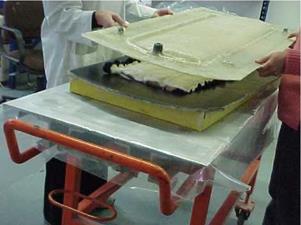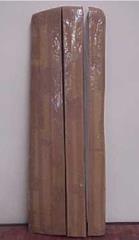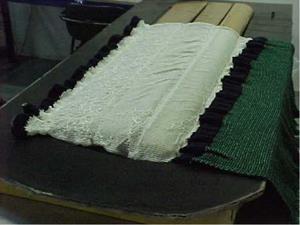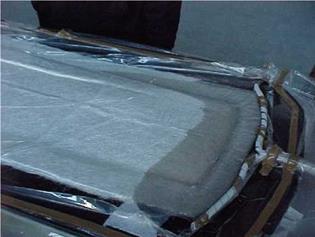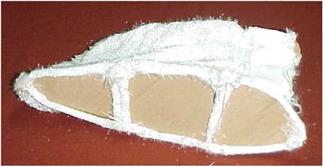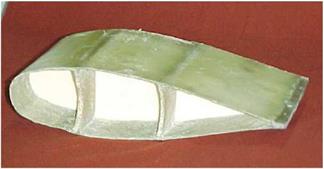The complexity of the preform shape required exterior and interior moulds that would generate the desired shape for the composite. The exterior mould (see Fig. 42) is made of a composite material reinforced with two layers of glass fibre matt. The three interior moulds (Fig. 43) that are to be introduced in the preform, are produced with polyurethane foam and have a protective layer.
|
Fig. 42. Exterior mould – inferior and superior components |
|
Fig. 43. Internal moulds – front view Description of the RTM process The injection process included the following stages (Nicolau et al., 2002): • mould cleaning and application of the separation liquid; |
• introduction of the interior moulds in the preform (Fig. 44) and covering with the supplementary tubular fabric;
• positioning in the exterior mould;
• mould vacuum closing;
• connecting the mould to the devices for resin injection and vacuum;
• vacuum formation inside the mould;
• resin preparation and catalyst introduction inside the bowl under 1 bar pressure;
• starting the injection process (Fig. 45).
|
Fig. 44. Introduction of the interior moulds in the preform |
|
|
Fig. 45. Resin injection process
The polyester resin was injected inside the exterior mould at low pressure (1,5 105 Pa) using the vacuum device. The injection process took approximately 30 minutes. After injection the composite material was subjected to a thermal treatment in order to complete the curing process. The composite wing is presented in Figure 46.
|
|
|
Fig. 46. Composite wing – aspect before and after resin injection |
5. Conclusions
Knitted fabrics are well used in the field of technical textiles, including composite materials with plastic matrix. As composite reinforcement, knitted fabrics have some negative points with regard to their mechanical behaviour, but this can be improved through structure (especially the use of in-laid yarns) and structural parameters.
Other issues concern the knittability of high performance fibres (volume of fibre damage during processing) and there are ways of limiting the filament breaking phenomenon – the modification of knitting elements, lower yarn tension, etc. The study presented in this chapter identifies as main cause of destruction the rob-back stage in the knitting process, when the yarns are pulled over the trick plate under high tension. The best approach to knitting high performance fibres seams to be a case by case approach, when the knitting conditions can be determined in order to obtain good quality fabrics.
Both weft and warp knitting technologies can be used to produce composite reinforcement. Warp knitting is best suited for structures with in-laid straight yarns (multiaxial fabrics), while weft knitting allows obtaining fabrics with three dimensional architecture, used as preforms for advanced composite materials. The examples of 3D knitted fabrics presented in
this chapter illustrate the idea that knitting is a viable option when considering the production of complex shapes. Further studies should explore diversification possibilities. Other directions for future development are: the design of knitted fabric in relation to 3D bodies, the simulation of fabric spatial geometry and properties prediction.

